How Much Does It Cost to Restore Water Damage?
If your home was affected by water damage, whether due to storm-related flooding, a broken water line, or some other problem, you probably already know how important it is to get the damage repaired quickly and effectively. This type of damage is unsightly to look at and left unaddressed leads to the growth of mold. In addition, it can cause appliances to malfunction and lead to serious structural issues. Two separate phases are involved in water damage restoration: first, the water extraction and cleanup, followed by structural repairs to building features, such as the roof, walls, ceiling, and/or flooring.
The national cost average for water restoration in a home is $1,200 to $5,000, with the average homeowner paying around $3,000 for standard gray water extraction with drying and drywall and ceiling repairs in a bathroom. This project’s low cost is $350 for a simple remediation caused by an overflowing toilet. The high cost is $50,000 for black water extraction in a basement, complete dry out and cleanup, and drywall and hardwood flooring replacement due to a sewer backup.
Water Damage Restoration Cost
| Water Damage Repair Cost | |
|---|---|
| National average cost | $3,000 |
| Average range | $1,200-$5,000 |
| Low-end | $350 |
| High-end | $50,000 |
In this guide
Water Extraction Cost by Type of Water
Water Damage Restoration Cost per Square Foot
Water Mitigation Cost by Class
Average Water Damage Restoration Cost by Type of Damage
Flood Damage Repair Cost by Room
Water Damage Repair Cost by Area
Labor Costs to Repair Water Damage
Restoration Steps
Emergency Water Damage Repair
Signs of Water Damage
What to Do Before Water Damage Restoration?
How to Prevent Flood Damage?
How to Prevent Mold After Water Damage?
Enhancement and Improvement Costs
Additional Considerations
FAQs
Water Damage Restoration Cost by Project Range
What Is Water Remediation?
Water remediation sounds complicated, but it is really just the process of cleaning up, drying out, sanitizing, and restoring (or rebuilding) materials and surfaces after any kind of water damage has occurred. While water damage remediation can be considered the same as flood cleanup, it also encompasses a broader category of repairs, including damage from leaks.
It is important that water remediation be done quickly to avoid further issues. Water damage can lead to issues like mold, bacteria, and wood rot.
Water damage can occur from several sources, which can change the way the remediation is handled. All water must be removed and cleaned, but clean water from a pipe is dealt with differently than water from an appliance like a washing machine. And water from a backed up sewer requires another method.
Reconstruction and restoration can only begin after the source has been assessed, and water has been removed. Once you know what water type you are dealing with and which areas it affects, the restoration process can start to return the area to its former condition.
Water Extraction Cost by Type of Water
Regardless of the water type, the first step in dealing with water damage is to remove the water from the area. This involves finding and stopping the source to prevent additional water from entering to help reduce the risk of structural damage to the property. Where the water comes from influences how much you will pay for extraction services.
Three types of water are involved in floods: clean, gray, and black. Gray water is also called sullage and comes from sources like bathtubs, sinks, and washing machines. It contains a small number of contaminants but no fecal matter. Ingesting it could cause health issues but will probably not be deadly.
Black water comes from sewer backups and toilets and has been contaminated with fecal matter. Ingesting it will have serious health consequences. Cleanup of black water can be more complicated, and it is important to treat all the contaminated surfaces against potential bacteria growth.
Clean water has no chemical or fecal matter, although it can cause structural damage to a building, including softening drywall 1, warping wood, and leading to mold and mildew growth. It is the easiest type to extract because it requires fewer safety measures.
Water extraction prices per sq.ft. are $3.75 to $7.50 depending on the volume, equipment used, and affected area.

| Type | Price per Sq.Ft. |
|---|---|
| Clean | $3.75 - $4.25 |
| Gray | $4.10 - $6.50 |
| Black | $7 - $7.50 |
Water Damage Restoration Cost per Square Foot
Once the water has been removed and the area dried out, you can begin restoring the damaged areas. The term “water damage restoration” refers to both extraction and repairing any damage caused by it. Water damage restoration involves the cost of removing the water and restoring the areas that were impacted. While the cost of extraction can be determined by the water type and volume, restoration can be harder to calculate. Several factors impact the cost, including the water, damage extent, location, and if the materials can be repaired or must be replaced.
There can be a wide range of costs associated with restoration. Most people usually pay a mixture of different costs for their water damage restoration. For example, if a pipe bursts and damages several walls and flooring, your costs to repair the walls and floors are different based on the material type, water type, and damage extent.
Below are some of the costs of water damage restoration for the various areas and materials in your home per square foot. Things like the water type and how long it was impacting the area before being removed impact your cost per square foot.

| Area | Average Restoration Costs per Sq.Ft. |
|---|---|
| Drywall | $1.50 - $3 |
| Mold | $4.75 - $5.50 |
| Carpeting | $4.75 - $10.50 |
| Plaster | $6.25 - $18.75 |
| Hardwood | $10 - $15 |
Water Mitigation Cost by Class
In addition to the water type and areas of damage, another way to see the project cost is by the class of damage. Each class is determined by the amount of water and size of the impacted area. There are four main classes, with the amount of damage increasing with the class number. Most homes only deal with issues from classes 1 to 3. Class 4 is generally in a catastrophic category, meaning that little can be done to restore the property due to the amount of structural damage, and the extent of the restoration usually means complete replacement.
Class 1 usually means only a small area of the home was affected, and there was minimal absorption in the surrounding structural materials. An example of a Class 1 project could be an overflowing toilet. An overflowing dishwasher or burst pipe in a kitchen could lead to a Class 2 repair job, which means structural damage to the surrounding floors and walls may require minor repairs. More severe projects, such as those listed as Class 3, typically include top down damage where water has affected the ceiling floor and walls. This could result from a leaking roof due to an ice dam build up. The most severe category is Class 4, which means a large area is likely affected, and significant structural issues that make accessibility a concern. Below you will see an idea of the average cost you can expect to pay based on the class of damage that occurred.

| Class | Average Range |
|---|---|
| Class 1 | $150 - $400 |
| Class 2 | $500 - $1,000 |
| Class 3 | $1,000 - $3,000 |
| Class 4 | $20,000 - $100,000 |
Average Water Damage Restoration Cost by Type of Damage
Water can cause several types of damage, depending on the location and what is affected by it.You may find that, whether due to flooding or gray water issues, it affects the floor, basement, ceiling, drywall, or even fixtures or pipes.
In most cases, damage can be broken into five broad categories - cosmetic damage, structural damage, electrical damage, damage or replacement of personal items, and mold growth. Depending on how bad the flood was, you may have one or more of these categories impacted. The more damage, the higher your total costs are for restoration.
Cosmetic is the least expensive to repair of the different damage types. This involves anything related to your home that does not impact the structure. This can be things like repairing the drywall, replacing wallpaper or paint, and taking care of damaged flooring. Most often, you see cosmetic damage at a minimum, but there may be more damage below if cosmetic damage is present.
Replacement of personal items may also occur alongside cosmetic damage. Electronics, clothing, furnishings, and other items can also be damaged at the same time as surfaces. Sometimes, items can be sent out for cleaning and repair, while other times you may need to have them replaced. This can lead to a wide range of costs, depending on what was involved.
Behind the cosmetic damage, you may find additional issues if the flood was extensive or it went on too long before being found and cleaned. Electrical damage is one of these areas. Electrical repairs must be handled by an electrician and dealt with before anything else because the damage to an electrical system can be dangerous. If electrical damage is discovered during cosmetic work, the cosmetic work stops until the electric damage is repaired.
Structural damage may also occur if the flood was extensive. This is damage done to the structure of the home, impacting its integrity. Examples of this damage can be warping or wood rot in the studs of the walls, cracking of the foundation or basement walls and floor, or settling of the home if enough water soaked into the landscaping. This damage can range from easy to repair to extremely expensive if the foundation was involved.
Regardless of how big or small a flood was, there is always the chance for mold growth if water entered your home. This is why it is important to deal with flood or water damage immediately to mitigate potential mold.
Mold remediation is the most costly repair type and may involve removal or cleaning of all affected surfaces. Mold spreads quickly, which is why drying the area out and using air scrubbers is so important after a flood to help halt the mold before it can cause significant and costly damage to the home. No matter how fast you dry out the area, always have a mold inspection done to ensure nothing has been overlooked.
Below are the average costs involved in each of the water damage types and restoration based on the area involved.

| Type | Price |
|---|---|
| Cosmetic | $150 - $1,000 |
| Personal Item Replacement | $500 - $1,500 |
| Structural | $500 - $3,000 |
| Electrical | $1,500 - $10,000 |
| Mold Remediation | $1,500 - $4,000 |
Flood Damage Repair Cost by Room
Floor and water damage can happen nearly anywhere in the home. Most often, the areas impacted are those with some connection to water, such as a bathroom, laundry room, or kitchen, and areas prone to moisture from the outdoors like basements. However, any area may be impacted whether through water coming in from an adjacent area because a nearby pipe leaked or ruptured in the ceiling or wall.
In many cases, the room can impact what you pay to restore it after a flood. In some instances, it is because there is more water in certain spaces, while in others, it is due to the surfaces and belongings in there.
Below are the average costs you pay to make full water damage restorations to the most commonly impacted areas of the home.

| Area of the House | Cost |
|---|---|
| Bathroom | $500 - $4,500 |
| Laundry Room | $1,000 - $5,500 |
| Living Room | $1,500 - $6,000 |
| Kitchen | $1,750 - $8,000 |
| Basement | $2,000 - $85,000 |
Bathroom Water Damage Repair Cost
You can expect to pay an average of $500 to $4,500 for water damage cleanup in a bathroom. Bathrooms are a common place for this to occur because of the presence of numerous pipes in the wall and several plumbing fixtures that can leak and overflow. Bathrooms tend to be less costly compared to other rooms in the home for a few reasons. They are usually smaller, and most surfaces are already water-resistant. Costs can be high if the issue is a backed up sewer line 2. Otherwise, clean water repairs can be much lower. Most often, bathroom repairs include extraction, and minor drywall, ceiling, and flooring repairs.
Flooded Laundry Room Repair
If you sustained water damage in your laundry room, you can expect the average cost to be the same as a bathroom ranging from $1,000 to $5,500. Laundry areas are also smaller spaces that frequently have water-resistant surfaces. The most common cause of this type of damage in the laundry room is an overflowing washer or leaking washer hose. Common repairs done to this area are flooring repairs, drywall repair, and sometimes minor electrical work.
Flooded Living Room Repair
Water damage in a living room costs an average repair cost of $1,500 to $6,000 to restore. The biggest reasons for the increase in costs are that living room areas tend to be larger, often suffer damage from overhead, and typically have flooring that is more expensive to repair. The most common causes for water damage in the living room are broken pipes and leaky roofs. And the most common repairs are to the ceiling, drywall, and flooring. In some cases, subfloors 3 and furniture need to be repaired or replaced, leading to higher costs.
Kitchen Water Damage Restoration
The kitchen is one of the most expensive areas for water damage repair. Repairs cost $1,750 to $8,000. Kitchen repairs can lead to higher costs because of the numerous repairs needed from one incident of this nature. This type of damage in the kitchen can result from flooding, broken appliance hoses, and overhead leaking. Repairs in the kitchen typically include flooring, drywall, ceiling, and electrical. Your biggest costs are likely to come from damaged appliances and cabinetry in the kitchen.
Basement Water Damage Repair Cost
Basement flood damage repair ranges from $2,000 to $85,000, depending on the water type and damage extent. Most often, this kind of damage in the basement results from flooding, though it can also occur from broken or leaking overhead pipes. The cost to clean your basement will cover a wide range with smaller sections of unfinished basements with concrete floors running on the low end, while finished basements with drywall, flooring, and ceiling tiles will be more on the high end. Repairs range from a simple extraction to major structural and electrical repairs.
Water Damage Repair Cost by Area
Water damage does not often impact every inch of a room, and those areas it does affect are not always impacted equally. Sometimes, you have major damage to a ceiling and minor damage to the walls or floor. Other times, the floor may have major damage, but the subfloor below may only have minor issues.
A large part of determining the cost of your water damage restoration is the damaged area. Each area can have a wide range of associated costs because it may be only minorly impacted or have a significant amount of damage. Some areas of damage tend to go hand in hand, such as floors and subfloors. Others may have a range of costs, depending on the type of surface it covers, such as hardwood or tile on a floor and wallpaper or paint on the walls. Below are the average project prices for certain repairs you may encounter after damage occurs.

| Area of Repair | Price for the Average Project |
|---|---|
| Floor | $200 - $2,000 |
| Subfloor | $250 - $750 |
| Wall | $275 - $2,200 |
| Ceiling | $325 - $1,100 |
| Roof | $350 - $1,400 |
| Foundation | $2,000 - $10,000 |
Water Damage Floor Repair Cost
Another common repair needed is flooring repair. Flood damage repair cost for flooring averages $200 to $2,000. Flooring damage can occur when there is minor damage from an overflowing toilet or from major issues like flooding. Whether flooring needs to be repaired and how extensively, depends on the flooring type, amount of water, and how long it was on the floor.
Some floors can be repaired by drying them out thoroughly. Others need to be completely removed and replaced. Some flooring types are not as badly affected as others, with vinyl and tile sometimes being able to be restored with only minor work. Other times, materials like carpeting must be completely removed and replaced. Some materials like hardwood vary depending on the amount of damage and floor type. For example, engineered hardwoods do better in floods than solid hardwoods. Below you will see the average cost per sq.ft. for repairing floors based on the type of flooring.

| Type of Floor | Average Cost for 200 Sq.Ft. |
|---|---|
| Vinyl | $200 - $1,200 |
| Tile | $200 - $2,000 |
| Carpet | $450 - $2,000 |
| Hardwood | $600 - $2,000 |
Subfloor Water Damage Repair Cost
Subfloor repair costs run an average of $250 to $750 to repair a 150 sq.ft. section of subfloor. In some cases where there is heavy damage or water has been standing for a period, there is a good chance the water has seeped through the flooring and damaged the subfloor. Damage can include buckling and warping, which can lead to unevenness and noise. If after the area is cleaned and dried and subfloor damage is found, your repair technician will likely replace the area of the subfloor that has been affected. If the subfloor is not properly cleaned and repaired, it can lead to mold growth and an uneven surface for the flooring above. It is common to replace the material above the subfloor if the subfloor itself is damaged, but some materials can be removed, dried, and replaced.
Water Damage Wall Repair Cost
One of the most common repairs included in the cost of restoration is wall repair, which runs an average of $275 to $2,200, depending on the project and wall type. This repair is most often needed when water comes in from the ceiling, such as roof leaks or when a pipe leaks or breaks in the wall. However, if you have a finished basement, you may have wall damage near the floor if a flood occurs there. The repair cost is directly influenced by the wall type. Drywall repairs are the least costly and most common. The drywall can be replaced in the affected areas and finished.
If you have a plaster wall, it needs to be rebuilt if it is fully saturated, which can be more costly. Brick walls are less likely to be damaged by water, but you may have some cracking if the flooding was significant. Repointing is the most common repair in this case. Cinder block walls are most likely to be damaged through significant flooding and may need crack repair.
Wallpaper likely must be replaced, even if the damage is cosmetic. This is due to the glue holding the wallpaper delaminating with moisture.
Below are the average repair costs based on the wall type.

| Type of Wall | Repair Prices |
|---|---|
| Drywall | $275 - $485 |
| Plaster | $500 - $1,000 |
| Brick Wall | $525 - $1,100 |
| Cinder Block Wall | $650 - $1,250 |
| Wallpaper (One Room) | $960 - $2,200 |
Cost to Fix a Water-Damaged Ceiling
A common water damage repair associated with roof leaks is ceiling repairs that run from $325 to $1,100. Water from the cracks in a roof or leaking or broken pipes above seeps down through insulation until it begins to damage the ceiling. This takes a while to notice and is often detected by discoloration and soft spots in the ceiling before actual leaking. Repairs usually include replacing the ceiling drywall and repainting the area. Costs are higher than drywall replacement on the walls because the ceiling is more difficult to work on.
Roof Water Damage Repair Cost
The cost to repair water damage on a roof averages $350 to $1,400, depending on the extent of the damage. The actual cost will largely depend on the roof material. Repairs will often include replacing the affected section, the underlay 4, and any nearby flashing 5 so that the area is made watertight again. Most roofing water damage occurs from leaks getting through the roofing material to the deck below. Roof leaks can happen due to normal wear and tear from a roof aging, damage from storms, and even a build up of ice that backs up water on the roof where it seeps through any small cracks.
Foundation Water Damage Repair Cost
Foundation flood damage repair costs run from $2,000 to $10,000 to fix a foundation with leaks. The price for repairs has a wide range because different types of repairs may be needed. In some cases, multiple repairs may be required. Most often, foundation damage occurs from large amounts of water standing for several days, such as when area flooding occurs. The impact from the rapidly flowing water from floods can lead to shifting, cracking, and even breaking of foundation supports.
Labor Costs to Repair Water Damage
The labor costs to repair water damage vary widely depending on the type of repairs needed. Companies specializing in water damage restoration typically charge between $70 and $200 per hour, depending on the water type, damage extent, and affected parts.
On top of labor costs, you should be aware that repair projects are subject to surcharges. If accessibility is an issue, extra equipment may be needed to reach the areas needing cleanup and repairs. Labor costs could increase by a minimum of $200 for safety equipment rental. There are often minimum charges for call outs because water infiltration can be considered an emergency. Having a crew out quickly can cost an additional $100 to $200 in fees.
You may also want to have a company come out to deal with the water cleanup, and then contract with other professionals for the restoration work. If you have used a specific professional in the past or have specialty materials in your home, you may want to hire your own workers for restoration rather than having the restoration company handle everything. You may have different costs if you do this.
Below is a breakdown of the average per hour, depending on the type of professional service.

| Type of Professional | Average Cost per Hour |
|---|---|
| Roofer | $35 - $90 |
| Painter | $40 - $60 |
| Electrician | $40 - $120 |
| Carpenter | $40 - $120 |
| Plumber | $75 - $130 |
Restoration Steps
Regardless of where the damage is located, what caused it, or which water type, every restoration follows a basic set of steps from initial inspection to restoration completion. Following this set process ensures that all of the water has been properly removed, damage has been assessed, repairs have been made, and the area is now safe for you to inhabit again.

Step 1
An inspection and damage assessment is always the first step in the restoration process. This is important because it lets the technician discover where the water is coming from, what type it is, and the extent of the damage so that a plan can be formulated for restoration.
Step 2
Removing the water is the next and most important step. If the water is not removed completely, then all other steps are moot. The remaining water could result in mold and mildew, leading to more significant problems. The process usually involves using industrial pumps 6 to dry out an area as much as possible through the use of powerful suction.
Step 3
Although extraction starts drying a water-damaged area, excess moisture is always left behind. Heaters and air blowers 7 help evaporate the moisture, while a dehumidifier removes droplets from the air. The length of this process is hard to determine as normal humidity in the home affects the process. Depending on the project scope, this step may begin in some areas while extraction is still being carried out in others. Your restoration technician will want to ensure that everything is as dry as possible before moving on to the next step.
Step 4
The next step in the process is a thorough cleaning and sanitizing of the affected area. Cleaning and sanitizing are extremely important after water extraction and drying, particularly if the water is gray or black. Although the water is removed, gray and black water require comprehensive sanitation to keep household members and pets safe. It is also necessary to ensure the air quality inside your home is at an acceptable level. Air scrubbers may be used in some cases to thoroughly clean the area and air so that nothing is left behind.
Step 5
The restoration process is the final step and, in some cases, may be one of the longest parts of the process. Restoration efforts may be minimal or extensive, depending on the underlying damage. It is important to address any damages after the water extraction to remove all possible avenues for mold and mildew. More damage can be uncovered during restoration, which may mean more drying or sanitation before restoration can continue.
Emergency Water Damage Repair
Some repair needs result in an emergency service call which can add an emergency fee of $50 to $200. While water damage may not be seen as an emergency, it often is. For example, if your home is flooded with black water because of backed up sewage, which creates a significant health hazard and should be remedied as soon as possible. You may also want to request emergency services if there is electrical damage that could lead to fire. A minor flood with clean water can lead to mold and mildew if not treated quickly, which is why it is important to call a service as quickly as possible.

Signs of Water Damage
Not all water damage is caused by a flood that is immediately noticeable. Water damage can be caused by minor leaks, moisture, condensation, and other small issues that build until they cause significant damage. You can help keep the damage to a minimum by staying aware of signs of water damage in your home.
Peeling, cracking, and discolored paint on the walls and ceilings are a significant sign that water damage has occurred. When moisture builds up inside the drywall, it swells and pushes against paint on the surface. More significant damage can show as sagging of the wall or ceiling.
Flooring damage can actually go unnoticed for some time if the spot is located in the corners of a room or against a wall. If you notice any warping, bowing, or humping of wood or laminate flooring, then the area is likely exposed. Another common sign is noticing wet areas in your carpet.
Mold, mildew, or a moldy smell that you cannot locate the source of may also indicate water or moisture damage. You may also hear the sound of water running or dripping in an area it should not be, or your water bill may increase for no apparent reason. If you notice any of these signs, it is a good idea to evaluate your home for water damage.
What to Do Before Water Damage Restoration?
You can take several steps to help limit damage while you wait for the professionals to arrive if you notice a significant flood or signs of water damage nearby. In an emergency flooding situation, always turn the power off immediately. This prevents any type of electrical fire from occurring.
To limit damage to personal belongings, remove any items that can be relocated. This could include personal effects such as clothing and accessories, rugs, draperies, and soft furnishings. Remove them from the affected area quickly, and if they are wet, set them aside to be dried and decontaminated. Any furniture that can’t be removed should be wiped down.
Remove any wall hangings, like photographs, if an area has sustained water damage. Keep them in a safe, dry place until they can be returned to the walls. Wipe down the walls, too, to alleviate excess moisture.
Open all windows in the room to assist with the drying process. If there are cabinets in the room, they should be left open. Avoid shutting the door to the impacted area since you don’t want to promote mold growth. You can begin circulating fans in the affected areas, and you can start removing some of the standing water if you have a sump pump 8 or shop vac if you can approach it safely.
How to Prevent Flood Damage?
While it is not always possible to prevent every instance of flooding or the damage it can cause, you can often prevent or mitigate some of the potential damage. Inspect your home, yard, and roof yearly to note any issues with drainage systems and remedy them early on.
Extend downspouts away from your foundation and improve yard grading if you have concerns about water collecting around your home’s foundation. Keep gutters and downspouts clear of debris, and make sure sump pumps empty out far enough away from your home. If you don’t have a sump pump installed, arrange to install one.
Inspect appliances and all plumbing fixtures monthly. Confirm hoses are secured with no drips. Hoses and faucets should not be actively leaking. Check the sealing around tubs and showers and caulk 9 as needed. Look at the pipes under the sinks and in your basement to note any issues like corrosion.
Install leak detectors 10 and automatic shut-off valves throughout your home. These can quickly detect a drop in water pressure and shut off the affected pipes before they have a chance to cause damage. Make sure you winterize pipes if you are not at home in the winter to prevent them from freezing and potentially bursting in the cold.
Schedule a roof inspection annually or after any significant storm. The inspectors could check for potential issues such as cracked or missing shingles.
How to Prevent Mold After Water Damage?
Mold and mildew can occur quickly after water or moisture has infiltrated an area. Mold is nearly always present in the air and grows on many surfaces, so it is important to act quickly if you want to try and prevent it after water damage has occured.
The best thing that can be done to prevent mold after water damage is to make sure all the affected surfaces are clean and dry. Bacteria and mold often grow when there is a wet environment, so you’ll want to make sure that you remove or replace rugs and carpets after damage has occurred.
Calling in professionals can help because they can open walls and remove surfaces to ensure everything gets dry. They can also use air scrubbers to remove mold spores and odors from the air, helping eliminate more mold growth.
You can also have a mold inspection 11 done, which can help detect early signs of mold growth to stop it before it progresses.
Enhancement and Improvement Costs
Basement and Foundation Waterproofing
Waterproofing your home allows you to remain proactive about preventing water damage. If your basement is prone to flooding or you notice condensation on the walls or windows, then consider basement waterproofing services that cost $3,000 to $7,000. Usually a combination approach of drains, sump pumps, and wall treatments are needed.
Water Leak Detection System Cost
Water leak detection systems prevent serious issues from occurring. The system actively monitors plumbing systems and uses sensors to sound an alarm if issues such as ceiling leaks arise. The system also includes automatic shut-off valves to stop leaks immediately. These systems cost an average of $500 to $1,500 and can be installed at any time by a licensed plumber.
Upgrade Washing Machine Hoses
Washing machine hoses made of rubber can dry out and crack. Replacing them with stainless steel braided hoses can help prevent sudden leaks and floods. A pair of stainless steel hoses costs around $45 to $75 installed.
Additional Considerations and Costs
- Permits. While cleaning does not require a permit, some restoration work may. Once the water is cleaned up and the restoration plan determined, speak to your local municipality about which permits may be required.
- DIY. DIY is never recommended for water damage restoration, but you can do some things, such as removing items from the area and keeping fans blowing. Professionals know how to take the right precautions to prevent health hazards when exposed to potential mold and black water.
- Insurance. Home insurance plans vary with different coverage limitations. Some cover issues such as flooding, but others require you to purchase separate flood insurance to cover flood damage repairs and restoration efforts. Speak to your insurance agent if you are unsure of your coverage.
- Water alarms. Water alarms are relatively low-cost and can be placed in areas like the basement to notify homeowners of flooding. They run off of batteries and cost around $20 for a basic version.
- Dehumidifiers. Dehumidifiers are a must for areas like the basement that are prone to water damage. Expect to pay at least $150 for a basement humidifier. Your damage restoration team should also bring in large units to help.
- Quick response. Damaged materials must be removed quickly with proper safety equipment worn by professionals. The EPA recommends flood cleanup efforts be performed within 48 hours whenever possible.
FAQs
- Can air in water pipes cause damage?
No, the air in pipes will not damage the piping system. Air can get into a closed system in several ways, and while it is annoying, it does not harm your pipes.
- How long does it take to repair water damage?
Cleanup and repairs are done in phases. At a minimum, water extraction and drying efforts take at least three days to complete. Restoration can take several more weeks to months, depending on the scope.
- What is the average cost of water damage restoration?
Homeowners pay around $1,200 to $5,000 for mid-range restoration services. Total costs depend on the level of damage and water type.
- Does homeowners insurance cover water damage?
Home insurance may cover it but always check with your provider before filing a claim. For instance, you may need flood insurance if the damage occurred due to a flood. Damages as a result of negligence or lack of maintenance may not be covered by your insurer. A standard home insurance policy covers sudden water damage in most cases.
- How long does it take for water damage to show?
This varies depending on the type and extent of the damage. Water damage may take months to show up if there’s a slow leak in the home. Post-storm damage may be visible immediately. Homeowners should watch for signs such as soft areas in the ceilings or walls or discoloration.
- How much does it cost to repair water damaged drywall?
Drywall repairs cost an average of $1.50 to $3 per sq.ft for water damage repair. An average homeowner spends $275 to $485 to fix drywall water damages.
- How can you tell where a water leak is coming from?
This depends on the water source and room you are in. Sometimes, you can hear the water running nearby. Other times, you may notice damp patches or wet spots, mold growth, bubbling or peeling paint, or sagging walls and ceilings. Water tends to leave the area it originates in quickly, so you may need a plumber to help make the final determination.
- How much does it cost to dry out water damage?
On average, it costs $2,000 to $7,000 to dry out a 500 sq.ft. basement with basic flood damage. That does not include any repair costs. After extracting as much water as possible, your technician will dry the area using blowers that put air over the area while drawing out the humidity in the room.
Remodeling Terms Cheat Sheet
Definitions in laymen's terms, cost considerations, pictures and things you need to know.See full cheat sheet.
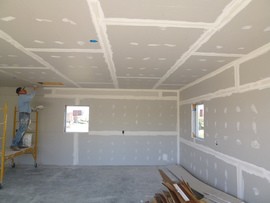 1 Drywall: Type of plasterboard, commonly used to build walls and ceilings, composed of gypsum that is layered between sheets of heavy paper
1 Drywall: Type of plasterboard, commonly used to build walls and ceilings, composed of gypsum that is layered between sheets of heavy paper
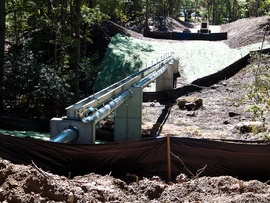 2 Sewer line: Principal pipe in a sewage system
2 Sewer line: Principal pipe in a sewage system
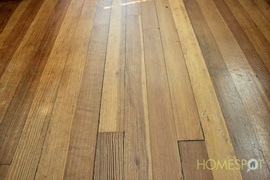 3 Subfloors: The bottom-most layer of a floor, supported by joists, over which finished flooring material is laid
3 Subfloors: The bottom-most layer of a floor, supported by joists, over which finished flooring material is laid
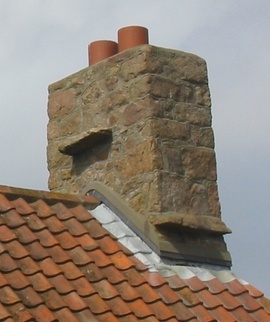 5 Flashing: Pieces of sheet metal used on roofs to cover joints, such as where the roof meets the wall, or around a chimney or skylight, to protect them and prevent water leaking through
5 Flashing: Pieces of sheet metal used on roofs to cover joints, such as where the roof meets the wall, or around a chimney or skylight, to protect them and prevent water leaking through
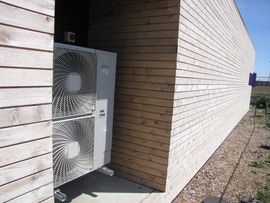 6 Pumps: A device used to move air, liquid, or gas by mechanical means
6 Pumps: A device used to move air, liquid, or gas by mechanical means
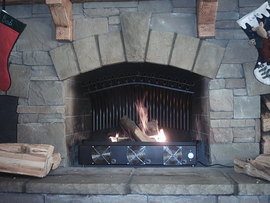 7 Blowers: An accessory that makes a fireplace more efficient by circulating the warm air in the fireplace to other areas of the home
7 Blowers: An accessory that makes a fireplace more efficient by circulating the warm air in the fireplace to other areas of the home
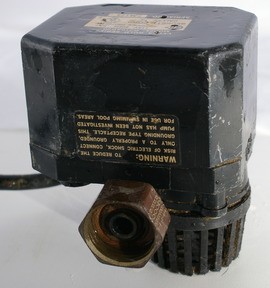 8 Sump pump: A mechanical device used to remove water from wet areas such as basements and crawlspaces in order to help prevent flooding
8 Sump pump: A mechanical device used to remove water from wet areas such as basements and crawlspaces in order to help prevent flooding
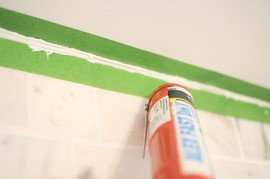 9 Caulk: A chemical sealant used to fill in and seal gaps where two materials join, for example, the tub and tile, to create a watertight and airtight seal. The term "caulking" is also used to refer to the process of applying this type of sealant
9 Caulk: A chemical sealant used to fill in and seal gaps where two materials join, for example, the tub and tile, to create a watertight and airtight seal. The term "caulking" is also used to refer to the process of applying this type of sealant
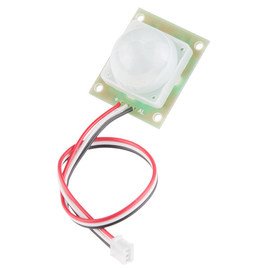 10 Detectors: Device that responds to a physical event or change in the environment by emitting an output signal
10 Detectors: Device that responds to a physical event or change in the environment by emitting an output signal
How much does it cost to restore water damage in my city?
Cost to restore water damage varies greatly by region (and even by zip code). To get free estimates from local contractors, please indicate yours.











